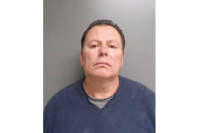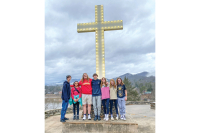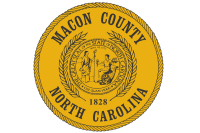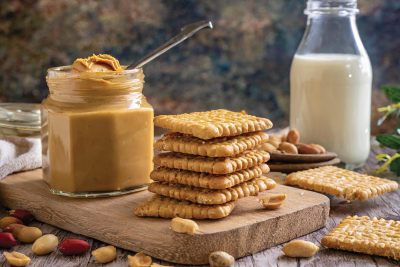A ‘free atmosphere to create’: Cherokee art school doubles its enrollment
Brian Kane used to teach someone else’s curriculum in someone else’s department at some other college.
Unsatisfied with his situation, however, Kane accepted a position at Oconaluftee Institute of Cultural Arts in Cherokee, where he and his students have a “free atmosphere to create,” he said.
Kane is the only full-time faculty member at the 10-student art institute, though four others regularly teach there.
The school is a nuts and bolts operation, located in a large warehouse off U.S. 19 in Cherokee. A small exhibit area at the entrance distinguishes it from the rest of the school, which is divided up into classrooms and collaborative work areas with white particleboard.
“It’s a studio environment,” said Jeff Marley, OICA’s program coordinator, adding that the size of the program makes it much more “hands on” and individualized.
The Oconaluftee Institute is a one-of-a-kind (or at least one of few) school that emphasizes Native American, particularly Cherokee, art history.
“There is nothing like this east of the Mississippi,” Kane said. “We’re trying to bring this cultural aspect into the arts.”
The art institute was established because leaders of the Eastern Band of Cherokee Indians wanted to offer some type of higher education on the reservation.
“There was a desire by tribal members to have a tribal college,” Marley said. “They wanted more focus on Cherokee (art).”
Although the idea began germinating in 2002, the art institute offered its first classes in 2007. Students can get their associate’s degree in art at the school and finish their bachelor’s degree at Western Carolina University or Southern Community College.
Although the Cherokee art school is already partnered with the community college, SCC will formally integrate and fund the program once it grows to 25 pupils. Currently, the Eastern Band gives about $150,000 to the art institute, and it receives an additional $500,000 in grants, which it applies for throughout the year.
“We were charged with seeking other funding, and we have,” Marley said.
The school has also reduced its budget by $11,000 — nearly $4,300 of which came from cutting its utility usage.
Unique experiences
OICA offers an inexpensive alternative to state or private colleges and universities. Five semesters — the time is takes to complete an associate’s degree — costs $3,962 at the Cherokee art school.
Anyone can apply; students do not have to be members of the tribe to study at the institute.
“Although we are a cultural program, all of our students might not be from tribal backgrounds,” Marley said.
Because of its connection to the Eastern Band, the school can give its students unique experiences. Several weeks ago, it was a private tour of The Museum of the Cherokee Indian to view art that was thousands of years old, pieces that are currently held in storage.
“Our students got to see and touch exhibits that are not open to the public,” Marley said.
During the past three years, the program has doubled its student population. It will graduate its third student this spring and another four or five in the next couple years.
Because the institute is so small, the program can be more “flexible,” Marley said.
Classes can change their schedule to be compatible with the availability of visiting artists, such as Native American painter and photographer Shan Goshorn.
For instance, students typically learn to shape clay first using only their hands and small paddles, which can add texture and imprints to the pottery. Only after that do they learn to make ceramics using a pottery wheel.
However, recent scheduling conflicts forced instructors to flip the ceramics curriculum on its head — a considerably easier task at a small school.
In addition to ceramics, the institute specializes in three other areas of study: sculpture, weaving and printmaking. It may eventually add painting and photography to its repertoire, but the institute wanted to focus initially on traditional forms of art.
OCIA acquired a printing press last year, which allowed them to expand their printmaking. What is unique about the institute’s press is that students can print items in either Roman letters or syllabary, the Cherokee written language.
Students have “the capacity to do anything they want,” Marley said. “What you can do with bookmaking and printmaking opens wide up with this press.”
Student art on display
The art institute will be showcasing its student art from Dec. 1 thru Dec. 16 and will hold a reception Dec. 5 from 5 to 7 p.m. The reception will include music, refreshments and a silent auction to benefit the school. Students will also be on-hand to talk about their art.
Two Cherokee artists featured in OICA Gallery
The Gallery at Southwestern Community College’s Oconaluftee Institute for Cultural Arts will feature two Cherokee artists in October as part of a new series of shows.
Horizons: Dean Reed & Henrietta Lambert opened on Oct. 1 and will run through Nov. 21. A reception for the artists will be held on Wednesday, Oct. 13, from 4 to 6 p.m.
“Opportunities to showcase local artists give our students a chance to network and derive inspiration from the community,” said Jeff Marley, program coordinator for OICA. “It is a natural fit to our program at OICA that we promote local artist.”
Reed has been working in clay for over 37 years, following a traditional Cherokee style of stamped pottery. He was a founding member of the Cherokee Potters Guild and a member of the Qualla Arts and Craft Mutual in Cherokee.
Lambert focuses primarily two-dimensional work, such as painting and drawing. She is the first graduate from OICA and is currently perusing her bachelors at Western Carolina University.
Historic Cherokee letterpress carries exciting potential for new art
The newest addition to Southwestern Community College’s Oconaluftee Institute of Cultural Arts holds a piece of Cherokee history. OICA will soon obtain a letterpress that will be used to print books in the Cherokee syllabary.
“We are bringing back the Cherokee history in true art form,” said Luzene Hill, OICA progam outreach coordinator.
Through a $68,846 grant from Cherokee Preservation Foundation and a $47,792 grant from the Institute of Museum and Library Services, OICA will purchase a metal press and develop a printmaking studio at its facilities on Bingo Loop Road in Cherokee.
Years ago, the Eastern Band of Cherokee Indians published a newspaper called Tsa la gi Tsu lehisanunhi, or the Cherokee Phoenix. This first Native American newspaper was printed on a hot-type letterpress in which each word is put together by hand, combining individual metal letters or characters.
“It opens up a whole new craft of book art for us, including printmaking, hand-papermaking and hand-bookbinding,” said Hill. “For our students, book art will blend fine arts with crafts.”
After 12 years, Sequoyah finished developing the Cherokee syllabary in 1821. Each character represents a syllable, instead of one sound, thus the name syllabary.
As in the Phoenix newspaper, the power of the Cherokee language rises through the printed word on the page, transforming from thoughts to art, Hill explained.
“You already feel the power of words but capturing them in a book through individual characters you’ve laid out in hot type and on paper you’ve made from linen or hemp fiber really helps you feel them in an art form, too,” said Hill.
As students learn to produce first the paper and then the books, they will also learn skills such as precision, technique, spacing and artistic layout composition, said Hill, who is consulting with noted instructor Frank Brannon.
Brannon, who runs his own letterpress studio, SpeakEasy Press, in Dillsboro, earned his master of fine arts in Book Arts at the University of Alabama and has recently taught Letterpress at the Penland School of Crafts and Papermaking and Printing at the John C. Campbell Folk School.
“One of Frank’s specialties is the Cherokee Phoenix newspaper,” said Hill. “He has explored and published copies from the original hand impressions of type from the Phoenix, found in a 1954 excavation of the New Echota historic site. He hand printed and hand bound the publications for exhibition.”
“The Phoenix was a bilingual weekly newspaper printed in parallel columns in Cherokee and English and one of its biggest subscribers was the British Library,” said Brannon, who also teaches at Book Works in Asheville.
The first paper that the Phoenix was printed on came from Knoxville by wagon and it took two weeks to arrive, according to Brannon. The last issue was published in 1834, shortly before the Cherokee removal to Indian Territory in Oklahoma.
“Students will learn the Cherokee history right along with the history of the letterpress,” said Hill.
The Cherokee language will also be incorporated into the course since the books can be published in the Cherokee syllabary, she added.
For more information contact Hill at 828.497.3945.
Oconaluftee Institute chooses Queen as program coordinator
Joel Queen has been named the new program coordinator and instructor at the Oconaluftee Institute for Cultural Arts in Cherokee.
“We stand on the edge of becoming a truly unique voice in the world for indigenous art and culture,” Queen said.
Queen, whose art is displayed in such places as the Smithsonian Institution and the British Museum in London, says that art is the same language wherever you go.
“The language of our Cherokee art is so storied with paintings, weaving, wood crafts, stonework and ceramics and I’ve spent my life creating in the Cherokee mediums,” said Queen, an enrolled member of the Eastern Band of Cherokee Indians. “I’ve been able to make a successful living at it but now it’s time for me to give back and that’s why I chose to work with OICA.”
Luzene Hill, program outreach coordinator for the institute, also has work exhibited in private and corporate collections across the country. Hill said that the institute will benefit from leadership by an artist whose work has been passed down over the generations. The institute gives students a foundation in traditional methods but also gives them the freedom to create contemporary art, Hill said.
Students of all skill levels are welcome at the institute, a joint endeavor of the Eastern Band, Southwestern Community College and Western Carolina University.
Students can earn an associate of fine arts degree from Southwestern. If they want to continue their education, they can transfer to Western Carolina University, or any other college in the state university system, as a junior to pursue a bachelor of fine arts degree.
“Not all of our students want to go for a higher degree, and we help them find their place in the market,” said Queen. “That’s important — they can be a great artist, but if they don’t know how to market their work, they won’t be able to make a living from it.”
At present the classes are small enough that instructors can individualize a program around the student’s skill level.
“Here at the institute we respect and honor the traditions of our Cherokee ancestors. But after students master technique, we encourage them to show innovation and creativity,” said Queen.
“For our Cherokee culture to evolve, our art must evolve first ... and art is the same language, no matter where you go.”
While the institute is a mix of traditional and contemporary, the students are also a mix. About half are Cherokee and the others represent a mix of cultures, according to Hill, an EBCI-enrolled member.
“The more students we get, the more programs we can offer,” she said.
For more information call 828.497.3945 or stop by the new location at 70 Bingo Loop Road in Cherokee.
Cherokee art institute gets new home
Several years ago, an idea was planted to establish an institution of higher education on the Qualla Boundary that would emphasize and preserve the rich artistic traditions of the Eastern Band of Cherokee Indians. Out of that dream, the Oconaluftee Institute of Cultural Arts took root — and today, the program is thriving.
The OICA was created out of a desire to establish a community college on the reservation and is only the second higher education institution in the country to offer a two-year degree in Native American arts.
The program celebrated its move into a new location in Cherokee last week. With its 5,600 square feet, studio spaces, a gallery space and a classroom to house its 10 students, the new home of the OICA is testament to how far the program has come.
The arts college was established in 2007 through a partnership with Southwestern Community College and Western Carolina University. It started out with two students in a space barely big enough to turn around. But while the program had humble beginnings, it was built around a lofty and unique vision.
“A lot of art has been focused out West, and a lot of people’s impression of Native American art is Southwestern art,” says Luzenne Hill, marketing director for the OICA. “But every tribe interprets their art in a different way.”
Specifically, the program aimed to showcase the artistic traditions of tribes east of the Mississippi River. Craftmaking, initially born out of necessity, has been passed down through generations by native tribes like the Eastern Band. Skills like basketweaving, woodcarving and pottery are so intertwined with native culture that many tribal members simply see them as a way of life.
“For decades, our people have been crafters, but haven’t always looked at their crafts as art,” said Juanita Wilson, chair of the OICA board.
The OICA teaches traditional art forms like basketweaving with native materials, pottery, and wood carving. But students also receive education in a variety of non-traditional art forms.
“We insisted that we keep tradition at the heart of it, but also wanted to go beyond that,” Wilson said.
Students learn traditional arts and crafts, but are also instructed on foundations of art education like western art history, drawing, and painting. Hill said the goal is to enhance the students’ art experience as much as possible, so that whatever speaks to them can also become a way of expressing their work.
“What we want to do is open people up and say, these are possibilities,” Hill said.
Henrietta Heeter, the first graduate of the program, knows perhaps better than anyone of the possibilities the program helps students to see. The OICA enticed Heeter to pursue her first higher education degree at the age of 50.
What finally convinced Heeter to return to school was, “the thought of our people having our own art institute, because there are amazing artists here,” she says.
Heeter says she’s enjoyed it all — from pottery, to carving, to weaving on a loom with native rivercane and white oak. Her true passion lies in painting, which she did at the OICA with pastels, charcoal, watercolors, and other materials.
“It opened me up to other possibilities with what I can do with my art,” Heeter says. “Hopefully I can now make a living off of it.”
Through the program, which directly transfers to a fine arts degree program at Western Carolina University, Heeter will go on to pursue an undergraduate degree.
The tribe, in conjunction with SCC and WCU, hopes to expand the OICA to attract students from all over the Southeast and Midwest, eventually increasing the program’s enrollment to 25 or 30 students.
Program leaders ultimately hope to locate the OICA in a permanent home in the old Cherokee High School.









